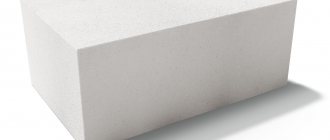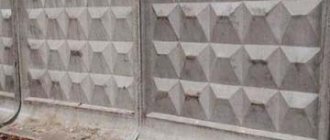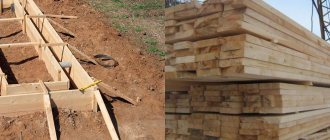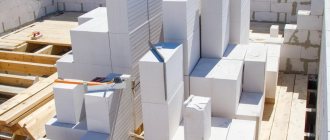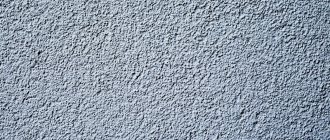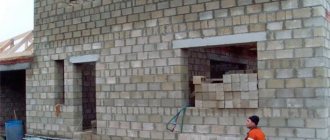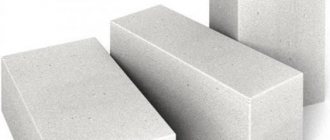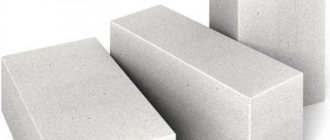- Kinds
- By purpose
- According to hardening conditions
- By type of binding components
- By type of silica components
- To size
- By shape
- By density
- According to frost resistance
- Advantages and disadvantages
- How to produce
- Where is it used?
- How to calculate the number of blocks for building a house
- Is it necessary to insulate walls made of gas silicate?
- Buy
Gas silicate is a building material with a cellular structure, which is obtained by autoclave processing of a mixture of cement, lime, fine sand and water with gas-forming additives, such as aluminum powder.
Building blocks are made from gas silicate in accordance with GOST 21520–89 or STB 1117–98 “Wall blocks made of cellular concrete. Technical conditions". The result is artificial stone. Gas silicate blocks are used for the construction of walls and internal partitions of houses and other structures: residential, commercial and industrial. Gas silicate is convenient in construction, it is quite light, can be sawed well, holes can be easily drilled in it and nails can be simply driven in.
Types of gas silicate blocks
By purpose
- Structural
– gas silicate blocks for the main walls of buildings. They are characterized by increased strength and withstand heavy loads. They have a density above 700 kilograms per cubic meter. They have a thermal conductivity of 0.18 – 0.2 W/(m °C). Brand D1000 – D1200. - Thermal insulation
- blocks with a reduced thermal conductivity - 0.08–0.1 W/(m °C). They are used only for insulation and are not intended for laying the main walls of buildings. They have a density below 400 kilograms per cubic meter. Brand D300 – D500. - Structural and thermal insulation
- blocks made of gas silicate, intended for the construction of low buildings - 1 - 3 floors. They have average thermal conductivity and strength. They have a thermal conductivity of 0.12 – 0.18 W/(m °C). They have a density of 500 - 700 kilograms per cubic meter. Brand D600 – D900. The most common blocks in low-rise construction.
According to hardening conditions
- Non-autoclaved
- blocks that harden naturally under atmospheric pressure. Hardening time ranges from 20 to 28 days. The main connecting link in the composition of such blocks is Portland cement. The disadvantages of non-autoclave gas silicate include low strength, low frost resistance and shrinkage of up to 5 mm per meter. - Autoclave
- blocks that harden in a special autoclave at artificial pressure of 11 - 13 bar and steam treatment - 190 degrees Celsius. This method of hardening allows you to obtain a dense gas silicate stone within a few hours, which is 2 times stronger than a non-autoclave stone. Its frost resistance is approximately 5 times higher than that of gas silicate blocks obtained using a non-autoclave production method. The shrinkage of autoclaved gas silicate is 10 times less than non-autoclave and is 0.3 - 0.5 mm per meter, and then in an autoclave, after which the blocks do not shrink. 50% of the cement in the autoclaved gas silicate is replaced with quicklime, which in the autoclave turns into calcium hydrosilicate, which ensures the strength of the product.
By type of binding components
- cement, with a Portland cement content of 50% or more;
- lime, containing more than 50% quicklime and gypsum, slag and cement additives not more than 15%;
- mixed, consisting of 15–50% cement, lime and/or slag;
- ash containing more than 50% highly basic ash;
- slag, consisting of more than 50% slag, including gypsum, alkali and lime.
By type of silica components
- based on natural materials such as fine sand;
- based on industrial products, such as ash, ferroalloys, ore dressing products and others.
To size
Gas silicate blocks do not have clearly defined dimensions according to GOST; depending on the manufacturer and type, they range within:
- Height – less than 500 mm;
- Width – less than 500 mm;
- Length – less than 625 mm.
Main dimensions of various brands of wall blocks:
- Height – 200/250 mm;
- Width – 200/250/350/375/400 mm;
- Length – 600/625 mm.
The main dimensions of various brands of partition blocks:
- Height – 200/250 mm;
- Width – 75/100/150 mm;
- Length – 600/625 mm.
By shape
Main types of gas silicate blocks by shape:
- Rectangular - blocks with smooth edges;
- Tongue-and-tongue - blocks with grooves and ridges on the edges for better alignment and to prevent cold penetration through vertical seams;
- U-shaped - blocks for installing lintels and armored belts on top of walls.
By density
The density of aerated concrete is indicated in the marking after the letter D in the value kg/m3. The higher the density, the stronger the gas silicate blocks and the less their thermal insulation ability. More dense blocks are used for load-bearing walls of buildings, and less dense ones for partitions and thermal insulation. The most common types of blocks by density:
- Thermal insulation:
- D300 – 300 kg/m3 Strength 10 – 15 kg/cm3;
- D400 – 400 kg/m3; Strength 25–32 kg/cm3;
- D500 – 500 kg/m3; Strength 25 – 46 kg/cm3;
- Structural and thermal insulation:
- D600 – 600 kg/m3; Strength 30 – 55 kg/cm3;
- D700 – 700 kg/m3; Strength 30 – 65 kg/cm3;
- D800 – 800 kg/m3; Strength 46 – 98 kg/cm3;
- Structural:
- D1000 – 1000 kg/m3; Strength 98 – 164 kg/cm3;
- D1100 – 1100 kg/m3; Strength 131 – 196 kg/cm3;
- D1200 – 1200 kg/m3; Strength 196 – 262 kg/cm3.
According to frost resistance
The frost resistance of gas silicate is marked with the letter F, after which the number of cycles of freezing and thawing of gas silicate without loss of its properties is indicated. The most popular types of gas silicate blocks in terms of frost resistance:
- F35 – 35 cycles;
- F50 – 50 cycles;
- F100 – 100 cycles.
Application area
Gas silicate blocks have gained the greatest popularity in private housing construction due to their high performance characteristics, large and correct size of the blocks, allowing construction to be completed in the shortest possible time, light weight of the products, which does not require the construction of a powerful foundation and, of course, their very affordable price.
Gas silicate blocks are widely used in the construction of industrial administrative and agro-industrial facilities with a height of no more than five floors.
Construction of residential buildings and multi-apartment buildings is allowed. An important factor is that, both in private and commercial construction, a low total cost of the project is achieved.
Gas silicate blocks are especially popular when carrying out redevelopment of premises - they allow you to make a permanent wall in a short time and at minimal cost.
Pros and cons of gas silicate blocks
Advantages of gas silicate
- Light weight.
Several times smaller than construction products of similar size. - Good compressive strength.
Structural, thermal insulation and structural blocks can withstand loads from 30 to 262 kg/cm3. Corresponds to bricks M50 – M250. - Low thermal conductivity.
In terms of heat-saving properties, gas silicate is close to wood. This allows you to save on heating costs. - Increased sound insulation.
Sound insulation is 10 times higher than that of brick. - Incombustible.
Refers to materials with fire resistance class - K0. When exposed to direct fire, it does not emit toxic substances. - Good level of vapor permeability.
Refers to “breathable” building materials, providing comfort in the room. - Quick laying.
The large size of the blocks allows for fewer steps to be taken when building walls, saving time. - Eco-friendly.
There are no toxic substances in the composition of gas silicate. - Easy to process.
Just saw, drill and tap. - Low price.
1 cubic meter of gas silicate is cheaper than 1 cubic meter of brick.
Disadvantages of gas silicate
- High water absorption.
If there are violations in construction, gas silicate can gain moisture and lose its properties. - Formation of cracks.
The material may crack due to shrinkage of the house and other mechanical stress. When using it during construction work, you need to be careful and follow the rules for constructing buildings made of gas silicate, such as: the use of a monolithic foundation, the use of reinforcement, the use of external finishing and insulation. - Low frost resistance.
But only non-autoclaved gas silicate has only 15 freezing and thawing cycles. Autoclave - from 35 to 100 cycles. - The need for proper organization of the wall pie.
The wall must be insulated from the outside and finished with finishing, but at the same time steam and moisture must be allowed to escape to the street so that it does not accumulate in the thickness of the wall. - There is a possibility of mold and mildew forming on the walls.
But only in the case of improper organization of external insulation and wall finishing, as well as technological violations during construction, for example, the wall was not allowed to dry completely before installing the insulation layer.
Gas silicate blocks are an excellent building material that has many advantages, but requires careful and proper use. Violations of technology and construction rules can lead to defects in construction.
Selection options
To select the optimal depth, several factors must be taken into account:
- number of storeys;
- wall type;
- climatic region.
According to SNiP, the higher the number of floors of a building, the more load it puts on the foundation and lower floors. There is a minimum value for this parameter for block material and this limit cannot be crossed, as this will lead to the destruction of the building.
Important ! According to standards, the minimum wall depth for a ceiling height of 2.5-3 meters should be 120-150 mm.
Load-bearing structures are subject to vertical load from the weight of the wall itself and other structures: floors, roofs, precipitation. Gas silicate has a calculated compression resistance of the masonry: it depends on the brand of the building mixture from which the block was made. The type of wall also influences the choice of thickness: for partitions it may be smaller. The climatic region where the house is built determines the thickness of the partitions: the colder the weather, the thicker the walls.
How is gas silicate produced?
The idea of producing gas silicate arose in 1918-1920 from the Swedish architect Ericsson. He developed a method for producing gas silicate and improved it throughout his life. For the first time, gas silicate was produced using the autoclave method in Sweden. Then other countries borrowed the technology for manufacturing this building material.
Stages of creating gas silicate blocks:
- Preparation of building materials.
Quartz sand is fed along with water to a specialized mill, where it is crushed into sludge. After which the sludge enters a special tank for mixing and homogenization. - Creation of cellular concrete mixture.
The sludge is fed to an aerated concrete mixer, in which it is mixed with gypsum, cement, lime and aluminum suspension in a certain sequence and dosage. - Molding.
The mixture is poured into molds in which it is kept for 4 hours at 40 degrees Celsius. During this time, hydrogen is actively released and the mixture increases in volume. Next, the mixture is kept for about 1 hour to obtain the desired plasticity. - Cutting arrays into separate blocks.
The resulting mass is removed from the mold and cut into separate blocks with special strings. - Autoclave processing.
The blocks enter a special steam chamber, in which they are kept for 12 hours at a pressure of 12 atmospheres and 180 degrees Celsius. - Package.
First, the gas silicate blocks are left to cool completely, after which they are packaged on an automatic line and sent to commercial warehouses.
Gas silicate is produced by such companies as:
- Kaluga aerated concrete;
- Elgad-ZSI;
- Bonolit Group.
Differences from aerated concrete
Gas silicate and aerated concrete blocks are types of cellular concrete. They share similar characteristics:
- porous structure;
- light weight;
- low thermal conductivity.
The difference between the blocks is noticeable in the composition and manufacturing technology. The basis of gas silicate is a mixture of lime and silica additives . Sand, water and aluminum powder are also used in its production . The amount of cement in the mixture is minimal or completely absent. Aerated concrete is characterized by a high content of Portland cement (up to 70%) and the other ingredients of the materials are similar. Blocks are easy to distinguish by color:
- aerated concrete – gray;
- gas silicate – white.
The production of cellular concrete is carried out in two ways: autoclave and non-autoclave. Aerated concrete can be produced by any of them, and gas silicate requires mandatory steam treatment under pressure in an autoclave . In terms of thermal insulation characteristics, resistance to compression and freezing, silicate concrete is superior to its analogue with a cement-sand base. Its advantages also include the clear geometry of the blocks; when laying, thin seams are obtained that minimize heat loss.
Where are gas silicate blocks used?
Gas silicate is used in construction for:
- Construction of load-bearing walls of low-rise buildings;
- Creation of internal partitions;
- Thermal insulation of buildings,
- Insulation of heating networks.
Selection of gas silicate blocks for various purposes based on the density and strength of the material:
- To create load-bearing walls in multi-story construction, gas silicate with a density of D1000 - D1200 (1000 - 1200 kg/m3) is used. They have a compressive strength from 98 to 262 kg/cm3. This is enough to build strong and reliable walls. But since the material is very dense, it has low thermal insulation properties. It is necessary to provide additional good insulation for the building, for example, lay out another layer of heat-insulating gas silicate blocks.
- For thermal insulation of buildings, blocks with a density of D300 - D500 (300 - 500 kg/m3) are suitable. They have a compressive strength from 10 to 46 kg/cm3. This is not enough to create load-bearing walls; these blocks are used only to create an additional layer of thermal insulation or for one-story construction.
- For the construction of low-rise buildings, in particular residential buildings with 1-3 floors, blocks that have both sufficient strength and a good level of thermal insulation with a density of D600 - D800 (600 - 700 kg/m3) are suitable. They have a compressive strength from 30 to 98 kg/cm3. Such houses do not need to be additionally insulated if they are located in a climate with warm winters.
Features of the material
Gas silicate is a type of autoclaved cellular concrete . It is a thermal insulation and structural material with a porous structure. The presence of air-filled cells gives the blocks improved heat and sound insulation properties and reduces their weight. a gas-forming agent - aluminum powder - to the mixture .
Unlike other cellular concrete (foam concrete, aerated concrete), the basis of a silicate aerated concrete block is lime with siliceous additives , and not Portland cement. The component allows you to achieve a fine-mesh structure with a uniform distribution of pores. Changing the proportion of air cells in the total mass of products affects their density and technical characteristics.
A large percentage of pores reduces the strength of products , but increases their thermal insulation properties. Blocks with a density of up to 500 kg/m³ are used for insulation of load-bearing structures, in low-rise construction, in the construction of garages and outbuildings. If the density of gas silicate reaches 700 kg/m³ , it is used in the construction of high-rise buildings.
Main characteristics:
- thermal conductivity – 0.14 W/m*C;
- vapor permeability – 0.17-0.3;
- frost resistance – 25-100 cycles;
- density – D200-D700;
- water absorption – 25-30%.
The service life of gas silicate is more than 50 years . The standard size of the blocks allows you to make an accurate preliminary calculation of the required material and adhesive mixture. It is worth considering the fragility of products and the possibility of damage during transportation and unloading.
How to calculate the amount of gas silicate for building a house
The exact calculation of gas silicate takes into account many different parameters and is a separate topic. Here is a simple method for calculating the required number of gas silicate blocks for the construction of a private house, which gives a good result:
- Calculate the perimeters of the external and internal walls of the house according to the construction plan.
- Calculate the area of external and internal walls by multiplying the perimeters by the heights.
- Sum up the area of all doors and windows for external and internal walls.
- The area of windows and doors is subtracted from the area of the walls. The areas of external and internal masonry are obtained.
- The value of the masonry area is multiplied by the thickness of the gas silicate block. The thickness of the block is selected based on the height of the house and the required level of thermal insulation. The volumes of gas silicate for masonry are obtained in cubic meters outside and inside the house.
- To determine the number of gas silicate blocks in pieces, it is necessary to divide the required volumes of gas silicate for masonry by the volume of 1 gas silicate block.
An example of calculating the number of blocks for external walls:
- We calculate the perimeter of the external walls of the house, for which we need to take its length and width from the house diagram: width - 30 m, length - 15 m. The length of the external walls will be 30 * 2 + 15 * 2 = 90 meters.
- Determine the height of the masonry. The height of the house without a basement is 3 meters. A gas silicate block measuring 200x300x625 will be used for the house. For masonry, glue 1.5 cm thick will be used. The height of the block with a layer of mortar will be 0.2 + 0.015 m = 0.215 m. The number of horizontal rows in the wall of the house will be 3/0.215 = 13.9 rows. We round and get a value of 14 rows for further calculations. The height of the masonry without taking into account the mortar is 14 * 0.2 m = 2.8 m.
- We calculate the total area of external walls made of gas silicate blocks. 90*2.8 = 252 m2.
- We determine the sizes of doors and windows. The house has 2 doors 2.1m by 1.2m and 10 windows 1.5m by 1.2m. The area of all doors is 2*2.1*1.2=5.04 m2. The area of all windows is 10*1.5*1.2 = 18 m2. The total area of doors and windows is 18 + 5.04 = 23.04 m2.
- We calculate the area of walls made of gas silicate without taking into account doors and windows. We subtract the area of windows and doors from the area of the walls - 252 - 23.04 = 228.96 m2.
- We calculate the volume of masonry of external walls. We multiply the area of the masonry by the thickness of the gas silicate block - 228.96*0.3=68.68 m3.
- We calculate the volume of one gas silicate block. We multiply the thickness, length and height - 0.3 * 0.2 * 0.625 = 0.0375 m3.
- We calculate the number of blocks per 1 square meter of wall masonry.
- We determine the number of gas silicate blocks for laying external walls. To do this, we divide the required volume of masonry by the volume of one gas silicate block - 68.68/0.0375 = 1831.4 blocks. When rounded, we get 1832 gas silicate blocks.
We repeat the same thing for the internal walls, only we use gas silicate for the partitions in the calculations.
How to determine the real density, as well as the weight of a cube. Calculation formula
The table shows simply the values, without any additional calculations. The weight of a cubic meter of gas silicate material is equal to the density indicated in the marking, but cases vary. For example, you suddenly wanted to check the material for the specified characteristics (it turned out that a pallet of blocks was missing, while a friend still had them, but he did not remember their description).
To calculate density, we must know the real mass. It is necessary to weigh one block, and then calculate it using the formula p=m/V.
- m - weight in kilograms. You will need to use a scale to weigh one block;
- p is the density (kilograms and m3);
- V is the volume (m3) that we learned above.
Is it necessary to insulate gas silicate blocks?
Gas silicate blocks need to be insulated in regions with cold winters to reduce home heating costs.
Blocks with densities D300, D400, D500 are themselves thermal insulating, so it is not necessary to use additional insulating materials for the walls where they are laid.
Walls made of gas silicate D600, D700, D800, D1000, D1100 and D1200 must be additionally insulated with mineral wool or expanded polystyrene.
To insulate the walls of a gas silicate house with mineral wool or expanded polystyrene, it is necessary to comply with the requirements for the insulating layer. It itself must be formed from several layers arranged in a certain sequence so that the wall breathes and liquid does not accumulate in the gas silicate.
It is necessary to install insulation and finish an external wall made of gas silicate blocks only after the wall has completely dried after installation.
Optimal parameter
The use of each size of stone must be provided for in the design documentation: deviating from the indicators is not recommended in order to avoid destruction of the building and other negative consequences. The most common options for walls :
- 300 mm;
- 400 mm;
- 500 mm.
300 mm gas silicate blocks are used to construct the walls of a residential building, but they require mandatory thermal insulation. If such a stone is used, then you need to carefully calculate the degree of load on the entire structure. 400 mm blocks are considered the most common and do not require thermal insulation: only at the request of the owner.
Gas silicate 500 mm is used only according to the project , since it is necessary to prepare a foundation of increased width for it. This stone can “eat up” the area inside the house, which is undesirable for small housing areas.
From the above, we can conclude that the standard for any region, the type of walls they are located in, is considered to be 400 mm, and the strength of the stone should be at least D600.
Manufacturers in the Russian Federation
In Russia there are many small enterprises and large factories that specialize in the production of gas silicate blocks. Among them there are 5 companies:
- " Bonolit ". The plant is located 22 km from Moscow in the city of Staraya Kupavna. The manufacturer has its own technology for manufacturing products, which is carried out using modern and high-tech equipment. All work processes are automated and regulated by highly qualified specialists. The price for 1 m3 of elements is from 3,500 rubles.
- " Aerobel " (Belgorod). The price for 1 m3 can start from 3200 rubles. The quality of the products presented in the catalog corresponds to reality. Such blocks are ideal for laying buildings up to 5 floors.
- " Pridonskaya VKSM " (Voronezh). The price for 1 m3 reaches 3290 rubles. The manufacturer guarantees that its products comply with building standards and environmental standards. The blocks are produced in various variations in size and technical parameters.
- " LSZ " (Lipetsk). The plant has been operating since 1938. The price per 1 m3 is 3,300 rubles. The elements are processed immediately before autoclaving. This reduces equipment wear, eliminates the need for additional transportation and prevents dust formation during processing.
- " Bikton " (Volzhsk, Mari-El Republic). The plant produces approximately 380,000 m3 of blocks per year. The elements have precise geometric dimensions and are available in densities starting from D350. The cost of 1 m3 is from 3450 rubles.
Work methodology
As soon as you manage to lay out the first row, you need to start laying the second. This should be done from the corner. To ensure horizontality, you need to install corner wooden slats. If the length of the wall is large enough, you can install intermediate beacons.
The laying of silicate blocks is carried out with bandaging of the seams. To do this, each next row must be shifted relative to the previous one by 8 cm or more. The glue protruding from the seams should not be rubbed down, but removed. It is better to complete the masonry in one approach, in this case there is no need to be afraid that the surface of the blocks will be exposed to the external environment.
The work may require reinforcement, because walls quite often undergo serious loads that deform the building. In order to eliminate cracks from bending deformations, it is necessary to divide the masonry into separate fragments using expansion joints or reinforcement. Finishing layers can be reinforced with fiberglass mesh. The method of strengthening will depend on the specifics of the building and operating conditions. Thus, for long walls you need to use a mesh, because it will be subject to pressure from wind loads.
